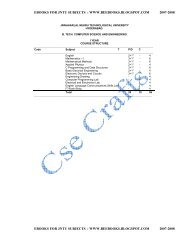Improving Student Writing Skills - cse crafts
Improving Student Writing Skills - cse crafts
Improving Student Writing Skills - cse crafts
Create successful ePaper yourself
Turn your PDF publications into a flip-book with our unique Google optimized e-Paper software.
Teaching Using the Traits of Good <strong>Writing</strong><br />
The Traits of Good <strong>Writing</strong> in<br />
Instruction<br />
While the basis of the Traits of Good <strong>Writing</strong> is an<br />
assessment rubric, you may also use the traits while<br />
instructing.<br />
Differentiation Using the Trait Assessment Data<br />
Once you have assessed, you can use the scores to choose<br />
lessons that are relevant to each student (Betts, 2004).<br />
You might ask the student who had the lowest-scoring<br />
trait to take special care with this trait on the next<br />
project or provide the student with extra practice on the<br />
trait. You can also use the traits to differentiate on a perclass<br />
basis. For example, you may notice that your class’s<br />
use of word choice lags behind other scores. In this case,<br />
you may choose to target the class with a lesson on word<br />
choice.<br />
The same is true of choosing small groups. No longer do<br />
we designate “bluebirds,” “redbirds,” and “finches” for<br />
groups based on reading level (Caldwell & Ford, 2002).<br />
Today’s small group is flexible, convened perhaps just<br />
for a few minutes in the course of one class period. In<br />
the next class period, you might create different groups<br />
altogether. Using the traits, if you notice that, for example,<br />
three students struggle with their use of ideas, you<br />
might pull them aside for a little extra help while other<br />
students are working independently.<br />
However, differentiating isn’t always easy. Like yesteryear’s<br />
one-room schoolhouse, we have many different<br />
instructional levels in our classrooms, and we need to<br />
find ways to teach each of these levels within our existing<br />
frameworks (Tomlinson, 2004). The crux of differentiating<br />
instruction (other than assessing in order to learn<br />
where each student needs additional work) is in finding<br />
http://www.books-foru.blogspot.com<br />
113




![JNTU ONLINE EXAMINATIONS [Mid 2 - JAVA] - cse crafts](https://img.yumpu.com/39435151/1/190x245/jntu-online-examinations-mid-2-java-cse-crafts.jpg?quality=85)
![JNTU ONLINE EXAMINATIONS [Mid 2 - ES] - cse crafts](https://img.yumpu.com/15318017/1/190x245/jntu-online-examinations-mid-2-es-cse-crafts.jpg?quality=85)
